| 登録情報 | データベース: PDB / ID: 3jpw
|
|---|
| タイトル | Crystal structure of amino terminal domain of the NMDA receptor subunit NR2B |
|---|
 要素 要素 | Glutamate [NMDA] receptor subunit epsilon-2 |
|---|
 キーワード キーワード | TRANSPORT PROTEIN / NMDA receptor / amino terminal domain / phenylethanolamine / Cell junction / Cell membrane / Glycoprotein / Ion transport / Ionic channel / Magnesium / Membrane / Phosphoprotein / Postsynaptic cell membrane / Receptor / Synapse / Transmembrane / Transport |
|---|
| 機能・相同性 |  機能・相同性情報 機能・相同性情報
cellular response to curcumin / cellular response to corticosterone stimulus / cellular response to magnesium starvation / sensory organ development / sensitization / EPHB-mediated forward signaling / Assembly and cell surface presentation of NMDA receptors / response to hydrogen sulfide / auditory behavior / dendritic branch ...cellular response to curcumin / cellular response to corticosterone stimulus / cellular response to magnesium starvation / sensory organ development / sensitization / EPHB-mediated forward signaling / Assembly and cell surface presentation of NMDA receptors / response to hydrogen sulfide / auditory behavior / dendritic branch / response to other organism / regulation of ARF protein signal transduction / fear response / apical dendrite / positive regulation of inhibitory postsynaptic potential / suckling behavior / response to methylmercury / response to manganese ion / response to carbohydrate / interleukin-1 receptor binding / cellular response to dsRNA / response to growth hormone / cellular response to lipid / negative regulation of dendritic spine maintenance / heterocyclic compound binding / regulation of monoatomic cation transmembrane transport / NMDA glutamate receptor activity / positive regulation of glutamate secretion / RAF/MAP kinase cascade / Synaptic adhesion-like molecules / response to glycoside / NMDA selective glutamate receptor complex / glutamate binding / calcium ion transmembrane import into cytosol / protein heterotetramerization / glycine binding / response to amine / small molecule binding / regulation of cAMP/PKA signal transduction / parallel fiber to Purkinje cell synapse / receptor clustering / startle response / monoatomic cation transmembrane transport / behavioral response to pain / regulation of MAPK cascade / response to magnesium ion / regulation of postsynaptic membrane potential / associative learning / action potential / extracellularly glutamate-gated ion channel activity / monoatomic cation transport / response to electrical stimulus / regulation of neuronal synaptic plasticity / glutamate receptor binding / positive regulation of excitatory postsynaptic potential / Unblocking of NMDA receptors, glutamate binding and activation / long-term memory / response to mechanical stimulus / detection of mechanical stimulus involved in sensory perception of pain / synaptic cleft / neuron development / positive regulation of synaptic transmission, glutamatergic / behavioral fear response / multicellular organismal response to stress / postsynaptic density, intracellular component / monoatomic cation channel activity / response to fungicide / glutamate-gated receptor activity / cell adhesion molecule binding / D2 dopamine receptor binding / regulation of long-term synaptic depression / cellular response to manganese ion / glutamate-gated calcium ion channel activity / presynaptic active zone membrane / response to cytokine / ionotropic glutamate receptor binding / ligand-gated monoatomic ion channel activity involved in regulation of presynaptic membrane potential / cellular response to forskolin / ionotropic glutamate receptor signaling pathway / protein tyrosine kinase binding / synaptic membrane / response to amphetamine / hippocampal mossy fiber to CA3 synapse / learning / excitatory postsynaptic potential / response to nicotine / response to cocaine / transmitter-gated monoatomic ion channel activity involved in regulation of postsynaptic membrane potential / hippocampus development / synaptic transmission, glutamatergic / cellular response to amino acid stimulus / regulation of long-term neuronal synaptic plasticity / response to calcium ion / postsynaptic density membrane / cerebral cortex development / beta-catenin binding / regulation of synaptic plasticity / cellular response to growth factor stimulus / response to toxic substance / calcium channel activity類似検索 - 分子機能 Glutamate [NMDA] receptor, epsilon subunit, C-terminal / N-methyl D-aspartate receptor 2B3 C-terminus / Response regulator / Ionotropic glutamate receptor, metazoa / Ligated ion channel L-glutamate- and glycine-binding site / Ionotropic glutamate receptor, L-glutamate and glycine-binding domain / Ligated ion channel L-glutamate- and glycine-binding site / Ligand-gated ion channel / : / Ionotropic glutamate receptor ...Glutamate [NMDA] receptor, epsilon subunit, C-terminal / N-methyl D-aspartate receptor 2B3 C-terminus / Response regulator / Ionotropic glutamate receptor, metazoa / Ligated ion channel L-glutamate- and glycine-binding site / Ionotropic glutamate receptor, L-glutamate and glycine-binding domain / Ligated ion channel L-glutamate- and glycine-binding site / Ligand-gated ion channel / : / Ionotropic glutamate receptor / Eukaryotic homologues of bacterial periplasmic substrate binding proteins. / Receptor, ligand binding region / Receptor family ligand binding region / Periplasmic binding protein-like I / Rossmann fold / 3-Layer(aba) Sandwich / Alpha Beta類似検索 - ドメイン・相同性 |
|---|
| 生物種 |   Rattus norvegicus (ドブネズミ) Rattus norvegicus (ドブネズミ) |
|---|
| 手法 |  X線回折 / X線回折 /  シンクロトロン / シンクロトロン /  多重同系置換・異常分散 / 解像度: 2.803 Å 多重同系置換・異常分散 / 解像度: 2.803 Å |
|---|
 データ登録者 データ登録者 | Karakas, E. / Simorowski, N. / Furukawa, H. |
|---|
 引用 引用 |  ジャーナル: Embo J. / 年: 2009 ジャーナル: Embo J. / 年: 2009
タイトル: Structure of the zinc-bound amino-terminal domain of the NMDA receptor NR2B subunit.
著者: Karakas, E. / Simorowski, N. / Furukawa, H. |
|---|
| 履歴 | | 登録 | 2009年9月4日 | 登録サイト: RCSB / 処理サイト: RCSB |
|---|
| 改定 1.0 | 2009年12月8日 | Provider: repository / タイプ: Initial release |
|---|
| 改定 1.1 | 2011年7月13日 | Group: Non-polymer description / Version format compliance |
|---|
| 改定 1.2 | 2017年11月1日 | Group: Refinement description / カテゴリ: software |
|---|
| 改定 1.3 | 2020年7月29日 | Group: Advisory / Data collection ...Advisory / Data collection / Derived calculations / Structure summary
カテゴリ: chem_comp / database_PDB_caveat ...chem_comp / database_PDB_caveat / entity / pdbx_chem_comp_identifier / pdbx_entity_nonpoly / struct_conn / struct_site / struct_site_gen
Item: _chem_comp.name / _chem_comp.type ..._chem_comp.name / _chem_comp.type / _entity.pdbx_description / _pdbx_entity_nonpoly.name / _struct_conn.conn_type_id / _struct_conn.id / _struct_conn.pdbx_dist_value / _struct_conn.pdbx_leaving_atom_flag / _struct_conn.pdbx_role / _struct_conn.ptnr1_auth_comp_id / _struct_conn.ptnr1_auth_seq_id / _struct_conn.ptnr1_label_atom_id / _struct_conn.ptnr1_label_comp_id / _struct_conn.ptnr1_label_seq_id / _struct_conn.ptnr2_auth_comp_id / _struct_conn.ptnr2_auth_seq_id / _struct_conn.ptnr2_label_asym_id / _struct_conn.ptnr2_label_atom_id / _struct_conn.ptnr2_label_comp_id
解説: Carbohydrate remediation / Provider: repository / タイプ: Remediation |
|---|
| 改定 1.4 | 2021年10月13日 | Group: Database references / Structure summary / カテゴリ: chem_comp / database_2 / struct_ref_seq_dif
Item: _chem_comp.pdbx_synonyms / _database_2.pdbx_DOI ..._chem_comp.pdbx_synonyms / _database_2.pdbx_DOI / _database_2.pdbx_database_accession / _struct_ref_seq_dif.details |
|---|
| 改定 1.5 | 2024年10月30日 | Group: Data collection / Structure summary
カテゴリ: chem_comp_atom / chem_comp_bond ...chem_comp_atom / chem_comp_bond / pdbx_entry_details / pdbx_modification_feature |
|---|
|
|---|
 データを開く
データを開く 基本情報
基本情報 要素
要素 キーワード
キーワード 機能・相同性情報
機能・相同性情報
 X線回折 /
X線回折 /  シンクロトロン /
シンクロトロン /  多重同系置換・異常分散 / 解像度: 2.803 Å
多重同系置換・異常分散 / 解像度: 2.803 Å  データ登録者
データ登録者 引用
引用 ジャーナル: Embo J. / 年: 2009
ジャーナル: Embo J. / 年: 2009 構造の表示
構造の表示 Molmil
Molmil Jmol/JSmol
Jmol/JSmol ダウンロードとリンク
ダウンロードとリンク ダウンロード
ダウンロード 3jpw.cif.gz
3jpw.cif.gz PDBx/mmCIF形式
PDBx/mmCIF形式 pdb3jpw.ent.gz
pdb3jpw.ent.gz PDB形式
PDB形式 3jpw.json.gz
3jpw.json.gz PDBx/mmJSON形式
PDBx/mmJSON形式 その他のダウンロード
その他のダウンロード 3jpw_validation.pdf.gz
3jpw_validation.pdf.gz wwPDB検証レポート
wwPDB検証レポート 3jpw_full_validation.pdf.gz
3jpw_full_validation.pdf.gz 3jpw_validation.xml.gz
3jpw_validation.xml.gz 3jpw_validation.cif.gz
3jpw_validation.cif.gz https://data.pdbj.org/pub/pdb/validation_reports/jp/3jpw
https://data.pdbj.org/pub/pdb/validation_reports/jp/3jpw ftp://data.pdbj.org/pub/pdb/validation_reports/jp/3jpw
ftp://data.pdbj.org/pub/pdb/validation_reports/jp/3jpw リンク
リンク 集合体
集合体
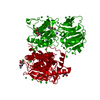
 要素
要素
 Trichoplusia ni (イラクサキンウワバ) / 参照: UniProt: Q00960
Trichoplusia ni (イラクサキンウワバ) / 参照: UniProt: Q00960 X線回折 / 使用した結晶の数: 1
X線回折 / 使用した結晶の数: 1  試料調製
試料調製 シンクロトロン / サイト:
シンクロトロン / サイト:  NSLS
NSLS  / ビームライン: X25 / 波長: 1 Å
/ ビームライン: X25 / 波長: 1 Å 多重同系置換・異常分散
多重同系置換・異常分散 解析
解析 多重同系置換・異常分散 / 解像度: 2.803→28.931 Å / Occupancy max: 1 / Occupancy min: 0 / SU ML: 0.78 / σ(F): 1.34 / 位相誤差: 27.71 / 立体化学のターゲット値: ML
多重同系置換・異常分散 / 解像度: 2.803→28.931 Å / Occupancy max: 1 / Occupancy min: 0 / SU ML: 0.78 / σ(F): 1.34 / 位相誤差: 27.71 / 立体化学のターゲット値: ML ムービー
ムービー コントローラー
コントローラー




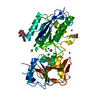


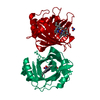
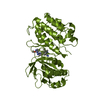
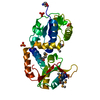
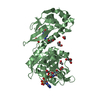
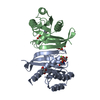
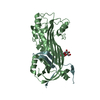

 PDBj
PDBj










